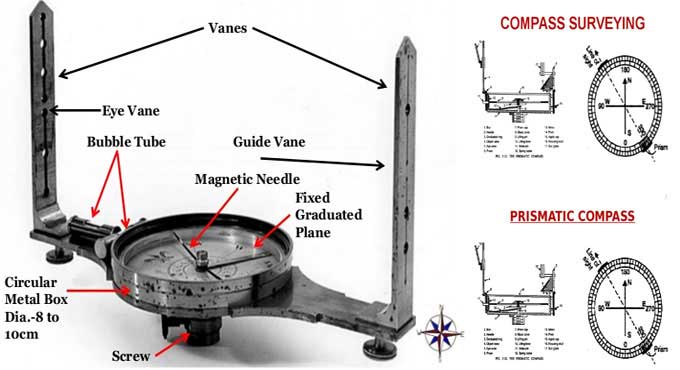
How Compass Surveying Works & the Advantages & Disadvantages
A compass survey consists of angular measurements using a compass to determine the position of objects. In places that are relatively flat and small, chain surveying can use. Chain surveys cannot use to cover large areas. Angle measuring instruments must use in such cases to observe the survey lines.
Types of Compass Surveying
Prismatic Compass
As a handheld or tripod-mounted magnetic compass, the prismatic compass is convenient and portable. During the needle insertion, a circular ring made of aluminum, non-magnetic material uses. The rivet will direct it when it reaches it.
Object vane and eye slit are attached to the compass box to define the line of sight in the magnetic meridian and the north and south end of the ring. The eye slit consists of a vertical slot cut into the top of the prism assembly, attached to the object vane, located on either side of a box, both hinged.
The sight vanes rotate around the meridian, which is the N-S end of the ring when an object is sighted. The prismatic compass has the advantage of allowing both sighting and reading of an object without moving the eye.
Surveyor Compass
As the surveyor's compass is a direct screw-in device, there is no needle to attach to the graduation. Therefore, the graduated ring does not point in a magnetic meridian because the needle is floating over the pivot.
A surveyor compass is very similar to an object vane. A metal vane with a fine slit makes up the eye vane. It is imperative that the needle reading takes from the top glass after first observing the objects.
Compass Survey Errors
- The instrument malfunctioned
- Due to the needle's imperfect straightness
- A bent pivot
- Needle moves slowly
- Pivot point that is blunt
- Unbalanced weight
- The object is not oriented vertically
- An obstruction in the line of sight
- Errors committed by individuals
- The compass box was not leveled correctly
- Centered incorrectly
- Signals cannot be accurately bisection
- Read and record carelessness
- Errors that are inherent in nature
- Different dedications
- Affection for the locality
- Clouds, storms, or other atmospheric changes can change the magnetic field.
Adjustment of Compass Surveying
Adjustment has to make due to different types errors mentioned above. A temporary adjustment and a permanent adjustment are both available.
Temporary Adjustment
It is necessary to make temporary adjustments every time the instrument is set up.
Centering
Keeping an instrument in an exact position on the station is called centering. Normally, prismatic compasses do not have fine-centering devices; they are associated with engineer's theodolites. Adjusting the tripod legs is the invariable method for adjusting the centering. The centering of the instrument may be judged by a plumb bob or by dropping a pebble from the center of the bottom of the instrument if one is not available.
Leveling
Leveling is done by holding the instrument in the hand in such a way that the graduated disc swings freely and appears level. The tap of a box can be leveled with the help of the ball and socket attachment of a tripod.
Using the prism for focusing
Both prism attachments are moved up and down for focusing till the reading comes to sharp and clear point.
Permanent Adjustment
Typically, these procedures are performed only when the prism's internal components are damaged or disturbed. The following are:
- Level adjustments.
- Pivot point adjustment.
- Sight vanes are adjusted.
- Needle adjustment.
Advantages of Compass Surveying
- Lightweight and portable, they are easy to carry.
- A station has fewer options for fixing it.
- Detailed survey lines are not affected by errors in the direction along a single survey line.
- Retracing old surveys is possible.
Disadvantages of Compass Surveying
- In comparison with other advanced surveying methods, it offers less precision.
- The device is easily affected by errors associated with the magnetic meridian, local attraction, etc.
- The error can also be explained by inaccurate leveling and poor sighting of the ranging rods.
Uses of Compass Surveying
Surveying areas that are large are typically not conducted by means of chain surveying, but by means of compass surveying. There are numerous obstacles and undulations on the plot that make chaining difficult. A compass survey is usually used if time is of the essence.
To get more details, watch the following video tutorial.
Video Source: CIVIL ENGINEERING FUNDA
Conclusion
An angular measurement happens using a compass, while a linear measurement happens using a chain or tape. Compass surveying is one of the branches of surveying. These things tend to attract magnets due to their electromagnetic properties and natural properties. Traversing is used for compass surveying. Several straight lines connect the points on a plot to form a traverse.


